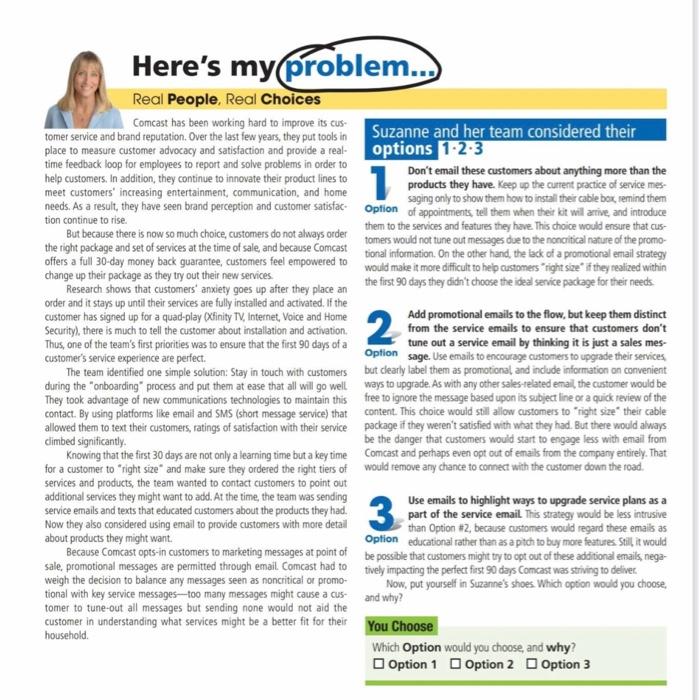Answered step by step
Verified Expert Solution
Question
1 Approved Answer
Here's my problem... Real People, Real Choices Comcast has been working hard to improve its cus- tomer service and brand reputation. Over the last few
Here's my problem... Real People, Real Choices Comcast has been working hard to improve its cus- tomer service and brand reputation. Over the last few years, they put tools in place to measure customer advocacy and satisfaction and provide a real- time feedback loop for employees to report and solve problems in order to help customers. In addition, they continue to innovate their product lines to meet customers' increasing entertainment, communication, and home needs. As a result, they have seen brand perception and customer satisfac- tion continue to rise. But because there is now so much choice, customers do not always order the right package and set of services at the time of sale, and because Comcast offers a full 30-day money back guarantee, customers feel empowered to change up their package as they try out their new services. Research shows that customers' anxiety goes up after they place an order and it stays up until their services are fully installed and activated. If the customer has signed up for a quad-play (Xfinity TV, Internet, Voice and Home Security), there is much to tell the customer about installation and activation. Thus, one of the team's first priorities was to ensure that the first 90 days of a customer's service experience are perfect. The team identified one simple solution: Stay in touch with customers during the "onboarding" process and put them at ease that all will go well. They took advantage of new communications technologies to maintain this contact. By using platforms like email and SMS (short message service) that allowed them to text their customers, ratings of satisfaction with their service climbed significantly. Knowing that the first 30 days are not only a learning time but a key time for a customer to "right size" and make sure they ordered the right tiers of services and products, the team wanted to contact customers to point out additional services they might want to add. At the time, the team was sending service emails and texts that educated customers about the products they had. Now they also considered using email to provide customers with more detail about products they might want. Because Comcast opts-in customers to marketing messages at point of sale, promotional messages are permitted through email. Comcast had to weigh the decision to balance any messages seen as noncritical or promo- tional with key service messages-too many messages might cause a cus- tomer to tune-out all messages but sending none would not aid the customer in understanding what services might be a better fit for their household. Suzanne and her team considered their options 1-2-3 1 Don't email these customers about anything more than the products they have. Keep up the current practice of service mes- saging only to show them how to install their cable box, remind them Option of appointments, tell them when their kit will arrive, and introduce them to the services and features they have. This choice would ensure that cus- tomers would not tune out messages due to the noncritical nature of the promo- tional information. On the other hand, the lack of a promotional email strategy would make it more difficult to help customers "right size" if they realized within the first 90 days they didn't choose the ideal service package for their needs. 2 Add promotional emails to the flow, but keep them distinct from the service emails to ensure that customers don't tune out a service email by thinking it is just a sales mes- Option sage. Use emails to encourage customers to upgrade their services, but clearly label them as promotional, and include information on convenient ways to upgrade. As with any other sales-related email, the customer would be free to ignore the message based upon its subject line or a quick review of the content. This choice would still allow customers to "right size" their cable package if they weren't satisfied with what they had. But there would always be the danger that customers would start to engage less with email from Comcast and perhaps even opt out of emails from the company entirely. That would remove any chance to connect with the customer down the road. 3 Use emails to highlight ways to upgrade service plans as a part of the service email. This strategy would be less intrusive than Option #2, because customers would regard these emails as educational rather than as a pitch to buy more features. Still, it would Option be possible that customers might try to opt out of these additional emails, nega- tively impacting the perfect first 90 days Comcast was striving to deliver. Now, put yourself in Suzanne's shoes. Which option would you choose, and why? You Choose Which Option would you choose, and why? Option 1 Option 2 Option 3

Step by Step Solution
There are 3 Steps involved in it
Step: 1

Get Instant Access to Expert-Tailored Solutions
See step-by-step solutions with expert insights and AI powered tools for academic success
Step: 2

Step: 3

Ace Your Homework with AI
Get the answers you need in no time with our AI-driven, step-by-step assistance
Get Started


